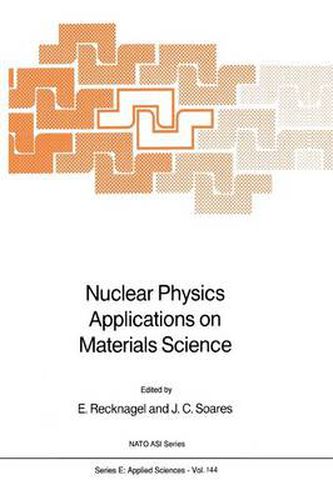Readings Newsletter
Become a Readings Member to make your shopping experience even easier.
Sign in or sign up for free!
You’re not far away from qualifying for FREE standard shipping within Australia
You’ve qualified for FREE standard shipping within Australia
The cart is loading…






This title is printed to order. This book may have been self-published. If so, we cannot guarantee the quality of the content. In the main most books will have gone through the editing process however some may not. We therefore suggest that you be aware of this before ordering this book. If in doubt check either the author or publisher’s details as we are unable to accept any returns unless they are faulty. Please contact us if you have any questions.
The last decade has seen a rapid development and growing importance in the application of nuclear physics methods to material sciences. It is a general desire to understand modern material problems on a microscopic scale, which, due to their inherent microscopic nature, made nuclear techniques highly suitable tools for basic and applied research in this field. The Advanced Study Institute on Nuclear Physics Applications on Ma terials Science brought together scientists active in different but closely re lated fields to review and discuss selected topics of bulk properties of metals, semiconductors and insulators as well as properties of surfaces, interfaces and thin films. Most of the excellent lectures and oral presentations of the School are collected in part I of the present volume, while extended abstracts of scientific work presented as posters are added in part II. The pleasant site of the ASI at Viana do Castelo and the northern province of Portugal, Alto Minho, provided the stimulating atmosphere for an in spiring School. Many people contributed to the scientific and social success of the institute. Thanks are especially due to the members of the local organizing committee, N. Ayres de Campos, M. Fernanda da Silva, A. Pedroso de Lima and my co-director J. Carvalho Soares. His permanent involvement in preparing and realization of the ASI was essential for this memorable School.
$9.00 standard shipping within Australia
FREE standard shipping within Australia for orders over $100.00
Express & International shipping calculated at checkout
This title is printed to order. This book may have been self-published. If so, we cannot guarantee the quality of the content. In the main most books will have gone through the editing process however some may not. We therefore suggest that you be aware of this before ordering this book. If in doubt check either the author or publisher’s details as we are unable to accept any returns unless they are faulty. Please contact us if you have any questions.
The last decade has seen a rapid development and growing importance in the application of nuclear physics methods to material sciences. It is a general desire to understand modern material problems on a microscopic scale, which, due to their inherent microscopic nature, made nuclear techniques highly suitable tools for basic and applied research in this field. The Advanced Study Institute on Nuclear Physics Applications on Ma terials Science brought together scientists active in different but closely re lated fields to review and discuss selected topics of bulk properties of metals, semiconductors and insulators as well as properties of surfaces, interfaces and thin films. Most of the excellent lectures and oral presentations of the School are collected in part I of the present volume, while extended abstracts of scientific work presented as posters are added in part II. The pleasant site of the ASI at Viana do Castelo and the northern province of Portugal, Alto Minho, provided the stimulating atmosphere for an in spiring School. Many people contributed to the scientific and social success of the institute. Thanks are especially due to the members of the local organizing committee, N. Ayres de Campos, M. Fernanda da Silva, A. Pedroso de Lima and my co-director J. Carvalho Soares. His permanent involvement in preparing and realization of the ASI was essential for this memorable School.